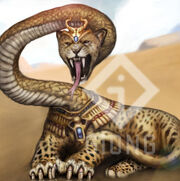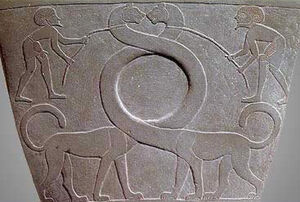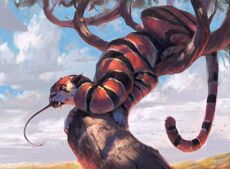
The Serpopard is a term applied by some modern researchers to what is described as a long-necked mythical animal known from Ancient Egyptian and Mesopotamian depictions. It is an animal whose depictions have been found on ancient Egyptian artifacts. Images of this creature have been painted on the Narmer Palette and the Small Palette of Nekhen. The Serpopard is a cross between a leopard and a serpent, bearing the body of a leopard and the head of a snake on a long neck. The Egyptians are well known for their accurate depictions of animals, leading some archaeologists to believe that the Serpopard is not a mythical creature but an extinct animal that existed during that time.
Serpopards stand approximately 3 feet tall at the shoulder; when their necks are fully extended, they can measure up to 20 feet long from nose to tail. They can weigh anywhere from 150 to 200 lbs. Some state that its appearance resembles a reptile's head on a long-necked lioness. The Serpopard has no markings on its body, round ears, and a tail that ends with a tuft of hair much like that of a lion.
History[]
Since it bears a strong resemblance of a lion, many believe that the Serpopard is a heraldic beast symbolizing royalty and protection, as this is the symbolic meaning of a lion in the religious concepts of Upper and Lower Egypt. The serpopard is a term applied by some modern researchers to what is described as a mythical animal known from Ancient Egyptian and Mesopotamian depictions. This term is not used in any original texts and is an interpretation made only recently. The image is featured specifically on decorated cosmetic palettes from the Pre-Dynastic Period of Egypt, and more extensively, as design motifs on cylinder seals in the Protoliterate Period of Mesopotamia (circa 3500-3000 BCE). Examples include the Narmer Palette and the Small Palette of Nekhen (Hierakonopolis). The cylinder seal displayed to the right displays the motif clearly.

Serpopard from Egyptian artifact

The image generally is classified as a feline and with close inspection resembles an unusually long-necked lioness. It bears the characteristic tuft of the species at the end of the tail, and there are no spots; the round-eared head most closely resembles the lioness rather than a serpent, because serpents do not have ears, and there are no typical serpent features such as scales, tongue, or head shape.
